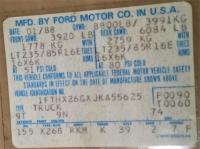1) note first of all that the GVWR is 8800 lbs
2) note the max weight the Front GAWR is 3920
3) note the max weight the Rear GAWR is 6084
These figures are based on what was ordered from the factory. My truck has a 460 gasser ad a C6 trans, has 4x4, has the Lariat extended cab and an 8' bed on it. What yours was ordered with will effect all three of these numbers above.
Now, you can't just add up the max for each axle (3920 plus 6084) as that comes to 10,004 lbs....because the max GVWR is only 8800 lbs! There is no discrepancy here; you can put a certain amount of weight on one axle as long as the other axle is not loaded to the point you have exceeded the GVWR of 8800 lbs.
In addition, the tag also shows the truck needs LT235R 16E tires (or better) and that the P series tires that come on the half-ton are not going to cut it for the weight of this vehicle.
Some of you may find that you are say, 100 or 200 lbs over the REAR axle GAWR. On my truck that would then be 6284 or 6384. This is of course, not factory advisable, however many choose to go that route. A key part of doing this would be if your GVWR was still UNDER the VIN tag rating (8800 for my truck). If this not only exceeded the rear GAWR but exceeded the GVWR....then you are overloaded. You can cosmetically correct the tail-dragging in the rear with springs/bags, etc. You are still overloaded, it just rides higher again which is visually better in my estimation.
This is a common question and is up to the poster to decide on...how much truck do I need and how much camper can I carry in it.
Just my 2 centavos here...














